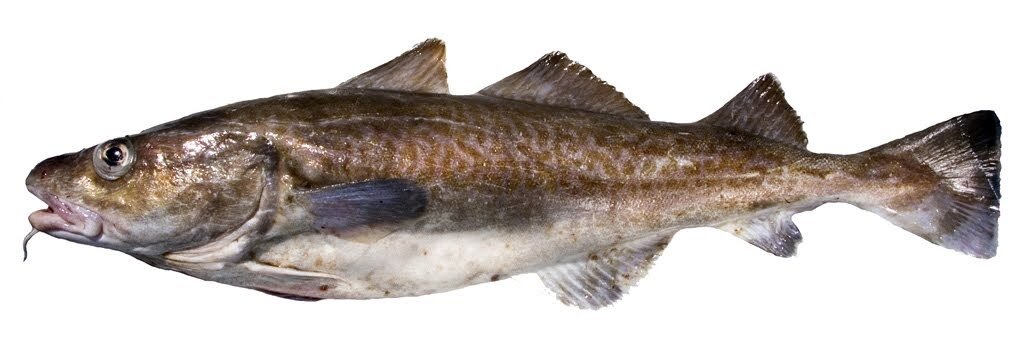True Cod
Availability: Winter
Also called Pacific Cod.
The Meat
The fishwife calls true cod, “true-fish” because as she says, “it's flavor is the flavor that most people think of when they they think of eating fish.” True cod meat is bolder in aroma and flavor than lingcod or rockfish, and flakier than halibut. As much as I hate deep frying, I have to admit this is the best fish and chips style fish that I have access to. It's also good in soups, stews or broils. Really, anything you can do with Atlantic cod, you can do with true cod. As per usual: see the “fishwife” page on seaforager.com for recipes.
Prep
True cod will arrive filleted, with the skin still on. Dig those cod spots!
Gear and fishery info
The true cod you get from me are jig all caught and fresh (not frozen). Most of them are caught in waters shallower than 1,000 feet. And as I said earlier this is a winter product, so don't expect it in June.
Jig caught True Cod is one of the few out of state fisheries I deal with. For one thing, any fisherman who is willing to fish hook and line in the middle of the Alaskan winter is someone I want to support. For another, true cod is an excellent fish that is largely caught by the metric ton and deserves a better fate than being turned into fish sticks, or prepackaged frozen fillets. Generally, this is a winter product shipped down from Alaska. I found out about this jig fishery from some of the Alaskan deckhands who came down from the frozen northlands in November 2013 to work on our local SF crab boats. I tried some sampled true cod and loved it. Here's what you can expect from the meat (see above).
#KnowYourFisherman
F/V Raven Bay, Captain Dustan Dickerson out of Dutch Harbor, AK
Fish Nerdism 101
According to Milton Love, true cod age at maturity and lifespan vary greatly. Many of them mature at 4-5 years and live until at least 17. These are often big meaty fish often weighing between 20-30 pounds. With lunkers as big as 40-50 also occasionally caught.
True cod were harvested in late winter by Native Americans who evidently relied on them when their preserved, dried or salted fish from earlier in the year started to go bad. In modern times, true cod was used primarily in the fish stick industry and is now primarily sold frozen and filleted.
The true cod you get from me are jig all caught and fresh (not frozen). Most of them are caught in waters shallower than 1,000 feet. And as I said earlier this is a winter product, so don't expect it in June.
There is some interesting stuff on true cod in the California Status Of The Fisheries Reports, and also in Milton Love's epic tome: Certainly More Than You Want To Know About The Fishes of the Pacific Coast, A Postmodern Experience.
Health concerns
I have not read any reports of health concerns in true cod (if you have, please let me know). They are a predatory species, with a fairly mixed diet, and do not live as long as their deep water neighbors the rockfishes.
Parting Shots
There are several exceptional things about true cod. First off true cod are, as advertised, a “true cod.” Why is this notable? Because a number of Pacific species called cod, or referred to colloquially as “cod” are not actually in the cod family. Most Californians are at least nominally familiar with “rock cod,” (family Sebastes, correctly known as rockfish), then there's lingcod of course, and the yummy, buttery, mouth watering, blackcod. Great fish all of them, each with it's own interesting life history—not to mention, distinctive flavors—but none of these species is in the true cod (gadiforme) family.
Then again, neither is a true cod really, really, really true.
Technically speaking the only true cod is the Atlantic cod. That great historic species fished to the brink of oblivion in the later part of the 20th century. The fish and chips cod. The Gloucester cod. The cod that arguably built the Eastern Seaboard. Lots of great literature out there about Atlantic cod. Go get a copy of Mark Kurlansky's aptly titled Cod. And if you still want more Four Fish by Mark Greenberg (a must read for anyone even remotely interested in sustainable seafood) has a stand up chapter on cod. By and large Atlantic cod populations were in reasonable shape until 30 years of industrial drag fishing had it's way with them. Articles about the devastating impact of drag fishing as well as photos of the denuded floor of the Atlantic Ocean, and satelite pictures of the scars left by bottom trawlers are available for your perusal on the internet. As are bleak videos with Sigourney Weaver doing the narration. So no need for me to re-hash this here. That's what Google is for!
Recipes
Facts
Scientific Name: Gadus macrocephalus
Habitat: A transoceanic species occurring at depths from shoreline to 500 m.
Diet: Opportunistic predators, they feed on a variety of fish and invertebrates, and scavenge as well. Small Pacific cod feed mostly on invertebrates, while large Pacific cod are mainly piscivorous (eat fish).
Size: schooling fish that can reach up to 58" and weigh up to 55 lbs.
Range: around the rim of the North Pacific Ocean, from the Yellow Sea to the Bering Strait, along the Aleutian Islands, and south to about Los Angeles.




